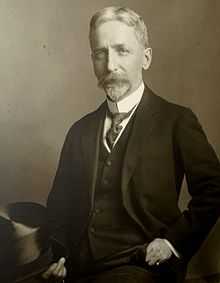William Raney
| William Edgar Raney | |
|---|---|
 | |
| The Hon. William Edgar Raney, KC | |
| 10th Attorney General of Ontario | |
| Preceded by | Isaac Benson Lucas |
| Succeeded by | William Folger Nickle |
| Personal details | |
| Born | December 8, 1859 Aultsville, Ontario |
| Died | September 24, 1933 (aged 73) Toronto, Ontario |
| Political party | United Farmers of Ontario |
| Religion | Presbyterian |
William Edgar Raney, K.C. (1859–1933) was a lawyer, politician and judge in Ontario, Canada, in the early twentieth century.
Early life
Born on a farm near Aultsville, Ontario,[lower-alpha 1] to Herman and Mary Raney, Raney was descended from Huguenot and United Empire Loyalist stock. Raney received his education first at a traditional log schoolhouse, then at St. Catherines Collegiate Institute, Trinity College in Kingston and finally Osgoode Hall, Toronto.
Raney was a well known lawyer in the first decades of the last century and came to the public eye through his opposition to gambling on horse racing, against which he had authored a series of reports.
His son, Paul Hartley Raney, a fighter pilot in the First World War, was killed in action, shot down over Roulers, Belgium (then German-held territory) on August 21, 1917. After the War, Raney made a number of appeals to the War Graves Commission to locate his son's final resting place. Unfortunately, no grave could be located.
Political career
Ontario Attorney General
Raney was initially a Liberal running unsuccessfully for the Ontario legislature in the 1914 provincial election. After the United Farmers of Ontario unexpectedly won the 1919 provincial election the agrarian party — pursuing an unusual matter of principle — had no lawyers in its caucus and so the new government of E.C. Drury approached Raney to accept the position of Attorney-General. He accepted and contested a by-election entering the Legislative Assembly of Ontario as the Member of the Legislative Assembly (MLA) for Wellington East. He was sworn in as the Attorney General of Ontario on November 14, 1919.
He became a leading force in the UFO-Labour government. In his ministerial capacity, he set out to abolish party patronage methods in the Ontario Ministry of Justice, and had the administration of the Ontario Temperance Act transferred to his office. Indeed, he became best known for what has been described as his 'zealous' application of Ontario's prohibition laws. When police and liquor officials were authorized to search automobiles and private yachts for illegal liquor, The Toronto Telegram observed that the only means of transportation where citizens could be free from Raney's agents were "balloons and submarines."[1]
However, one of Attorney General Raney's alcohol inspectors, the Reverend J O L Spracklin, was tried for manslaughter (days after the pastor's wife was in dangerous proximity to a shooting incident, Spracklin shot and killed a man who was engaged in the illicit liquor trade and was later acquitted of manslaughter).[2] The Government's and Raney's administration of the Province's liquor laws thus came under significant scrutiny. The Government's strict enforcement of the Ontario Temperance Act served to alienate voters from the cities, who largely felt that the party was too inclined towards rural causes and hostile towards urban issues.
Leader of Progressive Party
The return of only 17 UFO and 4 Labour MLAs in the provincial election of 1923 saw Premier Drury lose his own seat along with his government. Raney took over the Ontario leadership of the Progressives (as the UFO bloc of MLAs had become known) in January 1925 following the retirement of acting leader Manning Doherty. Raney led the opposition against the Ferguson government's plan to replace the Ontario Temperance Act with a Liquor Control Act which allowed alcohol sales through a government run Liquor Control Board. It was on this issue that he clashed with Ferguson and campaigned unsuccessfully against the loosening of Ontario's liquor laws as Progressive leader in the 1926 election, which returned only 17 Progressive, UFO or Labour MLAs.
Judicial appointment
A year later, Raney resigned his seat to accept an appointment to the Supreme Court of Ontario, where he served until his death in 1933.[3]
See also
External links
- "William Edgar Raney". www.findagrave.com.
Further reading
- Ian Bushnell (1992). The Captive Court. McGill-Queen's University Press. pp. 169ff. ISBN 0-7735-0851-1.
Notes
- ↑ Interestingly, another notable Ontario politician, Sir James Whitney, was born on an adjacent farm
References
- ↑ Claude William Hunt (1995). Whisky and Ice: The Saga of Ben Kerr, Canada's Most Daring Rumrunner. Toronto: Dundurn Press. p. 59. ISBN 1-55002-249-0.
- ↑ Robert Bothwell (1986). A Short History of Ontario. Edmonton: Hurtig Publishers Ltd. p. 126.
- ↑ "Justice Raney, Former Attorney-General, Is Dead". The Globe and Mail. September 25, 1933. p. 1.
| Party political offices | ||
|---|---|---|
| Preceded by Manning Doherty |
Leader of the Progressives 1925–1927 |
Succeeded by John Giles Lethbridge |
| ||||||||||||
| ||||||||||||||
.jpg)